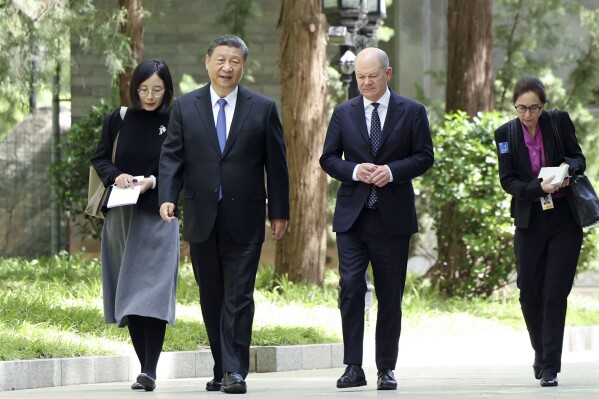Russia's invasion of Ukraine in 2022 sent shockwaves across Europe, prompting a reassessment of security priorities and defence strategies across the board.
In response to the escalating tensions and evolving geopolitical landscape, most European nations have embarked on a path of increased defence spending and the EU is attempting to mount and facilitate a joint endeavour in order to solve the continental security dilemma.
European countries cut spending as the threat of war receded
Since the end of the Cold War, European countries have mostly cut defence spending in favour of social, infrastructural or technological investments. According to the International Monetary Fund, the total defence spending of advanced economies, to which the eurozone members belong, has been almost halved since 1991 (according to figures for 2015).
Advanced economies used to spend more than 3% of their gross domestic product (GDP) on military goals, up until 1991. This number was lowered to as much as 1.6% of GDP by 2015. Only after Russia annexed Crimea in 2014, did the defence spending in Europe begin to rise, albeit not sharply on a general level. By 2019, Europe still wasn't investing a nominal 2% of GDP, which is mandatory under NATO rules.
A new sense of urgency has swept across Europe, as Russian advances in Ukraine bring back almost forgotten memories of the confrontational Cold War.
Russia's force in Ukraine shows potential for warfare remains
Minna Ålander, a Research Fellow at the Finnish Institute of International Relations (FIIA), explained to Euronews: "It is clear that wars aren't a distant phenomenon anymore and that European countries can't choose when and where to get involved. Therefore, the small armed forces most European countries have left from the expeditionary era are not sufficient anymore, be it as a deterrent against an expansion of Russia's aggression and especially insufficient as a defence against it."
The projected European increase in defence spending, which has today reached that of the end phase of the Cold War, according to the data published by Stockholm International Peace Research Institute, is also tied to the attritional war Russia is waging against Ukraine.
Edward Hunter Christie, a former NATO official and a Senior Research Fellow of the FIIA, set out the facts clearly in his comments for Euronews: "European states cannot durably supply Ukraine without increasing their own defence industrial capabilities and capacities. At the same time, to prepare against future, wider Russian threats, Europeans states themselves need to increase their defence capabilities and their readiness to fight."
Spending on defence needs to be increased
Taking into account the rising threats in various regions, not only in Eastern Europe, but also in Northern Europe, Sub-Saharan Africa and the Middle East, even 2% of GDP levels of spending won't be enough to provide Europe with enough defensive capacity for the foreseeable future.

Liana Fix, Fellow for Europe at the David Rockefeller Studies Program, shared her opinion on the matter: "It's plausible that the continent is heading towards Cold War levels of defence spending, which were between 3% and 4% GDP for many European countries".
These levels of spending will provide both new industrial and technological opportunities for the European economy, but they will also cause stress as budgetary spending gets diverted to the defence sphere.
As Christie put it: "Such preparation is of course costly. It requires higher national defence budgets across Europe as well as greater funding for existing or new supporting policies at both the national and EU levels, for example to support Europe's defence industrial base."
Defence spending can drive economic growth
Increased defence spending can act as a significant driver of economic growth, particularly in sectors related to defence production and technology. Defence contracts and procurement projects create employment opportunities, stimulate innovation, and foster the development of high-tech industries. Moreover, defence investments often have multiplier effects, generating ancillary benefits for suppliers and local communities.
Defence expenditure facilitates technological innovation and research, spurring advancements in areas such as cybersecurity, artificial intelligence, and aerospace engineering. These technological breakthroughs not only enhance military capabilities but also have broader applications in civilian sectors, contributing to overall national competitiveness and industrial resilience.
On the other hand, heightened defence spending necessitates diverting resources away from other areas of public expenditure, such as healthcare, education, and infrastructure. This can lead to trade-offs and compromises in funding essential social services and investments critical for long-term economic development and societal well-being. Balancing competing priorities becomes particularly challenging in times of fiscal austerity or economic downturns.
Rapid increases in defence budgets can strain national finances, exacerbating budget deficits and public debt levels. Sustaining elevated military expenditure over the long term requires careful fiscal planning and may entail difficult choices, including tax hikes, spending cuts, or borrowing. Failure to manage budgetary pressures effectively can undermine economic stability and investor confidence.

At the moment, those European countries geographically closer to Russia have adopted a more proactive approach to defence spending. They are at the forefront of the coming spending trend.
Alexander Lanoszka, Associate Professor at the University of Waterloo, told Euronews: "Poland, the Baltic countries, and Finland have been preparing extensively for varying lengths of time. In part because of their proximity to Russia, they generally have broad social and political consensus on the nature of their strategic environment as well as what to do about it."
This also means that heightened defence spending in democratic countries often presents a controversial topic, which needs to be debated as part of the political process. Dictatorships have it much easier in this regard – they don't have to consult their citizens, while planning bellicose actions. Democracies have to be deliberate, even when defending.
Germany's politicians still hesitant about spending levels
The largest economy of Europe – Germany - isn't doing all it potentially can in the defence department.
Liana Fox puts this into context: "Germany has the greatest potential, financially and with its defence infrastructure, to become a new pillar of Europe, but the seriousness in the debate about Germany's Zeitenwende has been lost – it will reach 2% GDP in defence spending by next year, but remains constrained due to government coalition infighting and the debt brake."
Recently, France has emerged as a leader in the defence sector as Minna Ålander explained: "Macron seems to have grasped what is at stake, if Ukraine was to lose this war, and he has started to deliberately stir up the conversation in Europe. France also took the lead in the new NATO multinational battlegroup established in Romania."
A negative factor is the distancing from European security trend coming from Washington, regardless of whether or not Donald Trump loses the coming presidential elections.
As Christie stated: "There are two main trends in US discourse, namely retrenchment or even isolationism, and a greater focus on Asia in order to contain China." Both of these pose a threat to the current level of European security.
The decision to increase defence spending in response to the Russian invasion of Ukraine entails complex trade-offs and considerations for European nations. While bolstering military capabilities can enhance deterrence, stimulate economic growth, and fulfil international commitments, it also poses challenges in terms of fiscal sustainability, opportunity costs, arms race dynamics, and diplomatic engagement. European nations will have to both increase their levels of defence spending and monitor the rise of populist political options carefully.
Disclaimer: The copyright of this article belongs to the original author. Reposting this article is solely for the purpose of information dissemination and does not constitute any investment advice. If there is any infringement, please contact us immediately. We will make corrections or deletions as necessary. Thank you.



